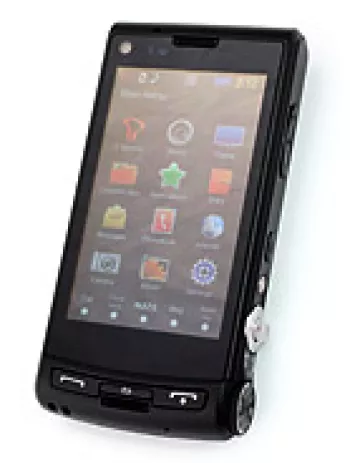
Overview of Samsung M8920
The Samsung M8920 was an intriguing device that was unfortunately cancelled before it could be officially launched. It was designed to be a high-end feature phone, combining multimedia capabilities with a sleek design. Although it never made it to the market, the speculated features of this phone were substantial, especially considering the era in which it was designed.
Design and Build
The dimensions of the Samsung M8920 were noted to be 115.8 x 56.9 x 16.3 mm, making it a compact yet slightly thick device due to its extensive hardware capabilities, particularly the camera module. It sported a classic black color, catering to a professional look. The phone was designed to use a Mini-SIM, which was standard at the time for many devices.
Display
The phone featured a 3.3-inch AMOLED display with a resolution of 480 x 800 pixels. This offered a pixel density of around 283 ppi, which would have provided crisp visuals and decent color reproduction, especially under direct sunlight where AMOLED displays are known to excel. The screen-to-body ratio was approximately 47.0%, which was typical for phones of its time.
Camera Capabilities
The camera was one of the standout features of the Samsung M8920. It was equipped with a 12 MP primary camera featuring auto-focus and a 3x optical zoom. The camera module was backed by both a Xenon flash and an LED flash, allowing for better low-light photography. Video capturing capabilities included 720p recording at 30fps, making it quite advanced compared to many contemporaries in the feature phone category.
Internal Specifications
Under the hood, the Samsung M8920 offered 8GB of internal storage, which was considerable for a feature phone. Additionally, it supported expandable storage via a microSDHC slot. The device was designed to host features such as a full phonebook with Photocall functionality, and it maintained call records seamlessly. Unfortunately, details regarding RAM and the specific processor remain unspecified.
Battery and Power
The device was powered by a removable Li-Ion 1500 mAh battery. This capacity, in conjunction with the phone's power-saving features as a feature phone, promised a respectable battery life, especially for users who wouldn't require extensive app usage as with modern smartphones.
Connectivity
The Samsung M8920 was equipped with GSM and HSPA technology. It supported 2G and 3G bands, including GSM 850, 900, 1800, 1900, and HSDPA 900, 2100 bands, with network speeds reaching HSPA 7.2/5.76 Mbps. For local connectivity, it offered Wi-Fi 802.11 b/g, DLNA, Bluetooth 2.1 with A2DP for audio streaming, and a USB 2.0 port for data transfer. GPS and A-GPS were also present for location services.
Multimedia and Features
The phone supported stereo FM radio with RDS and had a loudspeaker for media playback but lacked a 3.5mm audio jack. Java support was present, enabling users to download and run additional applications, and it featured SMS, MMS, Email, Instant Messaging, and Push Email for communication. The phone had basic sensors like an accelerometer and proximity sensor, which were versatile for various applications and functionalities.
User Experience
While operating on a feature phone platform, the Samsung M8920 aimed to deliver a user-friendly experience with capabilities that overlapped between traditional phones and emerging smartphones. Its intuitive user interface, supplemented with downloadable games and advanced browser capabilities (WAP 2.0/xHTML, HTML), was designed to cater to tech enthusiasts and everyday users alike.
Implication and Impact
The Samsung M8920, despite its cancellation, symbolized an era of transition in the mobile industry. It showcased cutting-edge technology such as advanced camera systems and multimedia features in a pre-smartphone world. As such, it represents a pivotal moment in mobile technology evolution, hinting at future trends where multimedia experiences would become smartphone cornerstones.
Key Features of Samsung M8920
- Network Technology: GSM / HSPA
- Compact Design: Dimensions of 115.8 x 56.9 x 16.3 mm
- AMOLED Display: 3.3 inches with a resolution of 480 x 800 pixels
- 12 MP Main Camera: Autofocus with 3x optical zoom, Xenon and LED flash
- Expandable Storage: microSDHC dedicated slot
- Internal Memory: 8GB
- Video Recording: 720p at 30fps
- Connectivity: Wi-Fi 802.11 b/g, Bluetooth 2.1, A2DP
- Positioning: GPS and A-GPS support
- Stereo FM Radio with RDS
- Removable Battery: Li-Ion 1500 mAh
- Sensors: Accelerometer, proximity
Disadvantages of Samsung M8920
- Status: The device was cancelled and not officially released.
- Weight: The weight of the device is unspecified.
- SIM Type: Supports only Mini-SIM, which may be outdated for current standards.
- Screen Size: The screen-to-body ratio is relatively low at approximately 47.0%.
- Selfie Camera: No front-facing (selfie) camera available.
- 3.5mm Jack: Lacks a 3.5mm headphone jack which is standard in many devices.
- Bluetooth: Version 2.1, which is outdated and lacks newer features of recent Bluetooth versions.
- Battery: The battery has a capacity of only 1500 mAh, which may be inadequate by modern standards.
View Also
More Phones
All Rights Reserved +14266 Phones © Mobilawy 2025

























